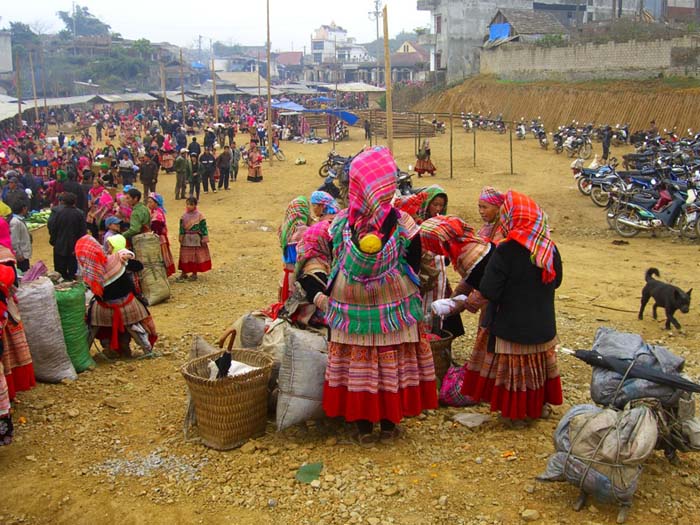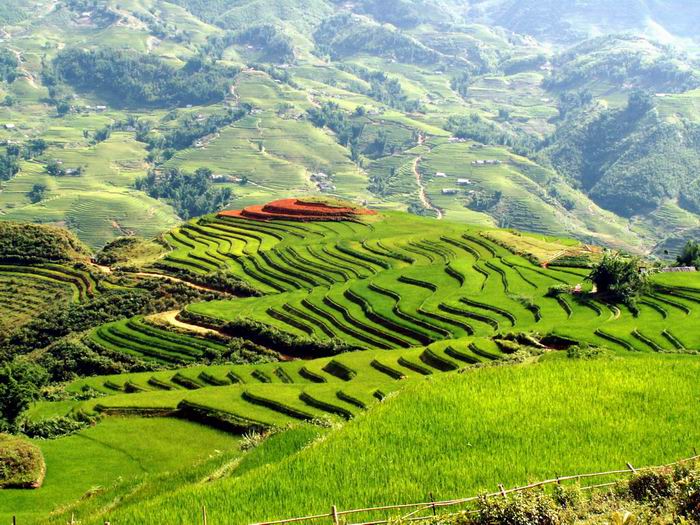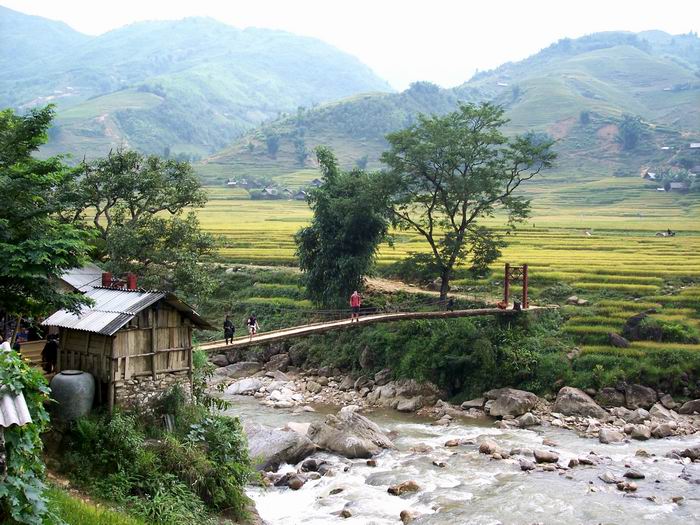The Queen of the Mountains, Sapa sits regally overlooking a beautiful valley, lofty mountains towering over the town on all sides. Welcome to the destination in northwest Vietnam, gateway to another world of mysterious minority cultures and luscious landscapes. The spectacular scenery that surrounds Sapa includes cascading rice terraces that spill down the mountains like a patchwork quilt. The mountains are often shrouded in mist that rolls back and forth along the peaks, offering tantalising glimpses of what lies in wait on a clear day. The valleys and villages around Sapa are home to a host of hill-tribe people who wander in to town to buy, sell and trade. In a beautiful valley close to the Chinese border, Sapa is a former hill station built in 1922. History has not always been kind to Sapa. and the series of conflicts that swept over Vietnam nearly saw it wiped off the map. From WWII, successive wars against the French and the USA, not forgetting the more recent border skirmish with China in 1979, took their toll. The old hotels built by the French were allowed to fall into disrepair and Sapa was forgotten by all but a handful of residents. With the advent of tourism, Sapa has experienced a renaissance. Bad roads have been upgraded, many streets have been given names, countless new hotels have popped up, the electricity supply is reliable and the food has improved immeasurably. Inherent in all of this prosperity is cultural change for the Montagnards, many of whom are now well versed in the ways of the cash economy and are reaping the financial rewards of the tourism influx. The downside is a building boom that has seen one hotel after another raise the roof in a continual quest for better views. Height restrictions are rarely enforced and the Sapa skyline is changing for the worse. Another inconvenience that will not change is the weather. If you visit off-season, don't forget your winter woollies. Not only is it cold (like 0??C), but winter brings fog and drizzle. Quite why the French alighted on this spot is difficult to comprehend: it must have been one of those rare clear days when the views are to die for. The chilly climate does have its ad vantages, however. The area boasts temperate zone fruit trees bearing peaches and plums, and gardens for raising medicinal herbs. The dry season in Sapa lasts from around January to June. January and February arc the coldest (and foggiest) months. From March to May the weather is often excellent, and the summer is warm despite the rains between June and August. The window from September to mid-December is a rewarding time to be in Sapa, though there is a bit of lingering rain at the start and the temperature dips by December. Sapa would be of considerably less interest without the H’mong and Dzao people, the largest ethnic groups in the region. The billowing red headdresses of the Red Dzao are visible all over town, a surreal sight amid the accelerating development. The H'mong are more numerous and canny traders. Their villages may look medieval but most ,will have a mobile phone and an email address to stay in touch. Traditionally, they were the poorest of the poor, hut have rapidly learnt the spirit of free enterprise. Most of the Montagnards have had little formal education and are illiterate, yet all the youngsters have a good command of English, French and a handful of other languages. If possible, try to visit during the week, when Sapa is less crowded and more intimate. Crowds flock to Sapa for the Saturday market, but a smaller market is held every day There is plenty to see on weekdays, and there are lots of interesting villages within walking distance of the centre.
Sights & Activities:
The easiest trek in town is to follow the step’s up to the
Sapa radio tower for killer views of the valley. Montagnards from
surrounding villages don their best clothes and go to the
Sapa market most days. Saturday is the busiest day, and
the town is choking with tourists as the evening "love market"
is a big magnet for
organised tour groups from Hanoi. If you'd
rather enjoy Sapa at a more sedate pace, avoid the Saturday
market. The love market is speed dating minority style. Tribal
teenagers trek into town to find a mate. It's all very coy, but
unlike many of the more remote love markets in the region, it
has become very commercial in recent years, These days there are
more camera-toting tourists than love-sick Montagnards, as well
as a smattering of opportunist prostitutes on the scene.
TREKKING TO LOCAL VILLAGES
It is quite easy to undertake day
hikes through the valleys
around Sapa without the assistance of a guide. However, for
overnight stays in villages and longer treks into the mountains,
it is advisable to hook up with a local guide. Where possible we
suggest the use of minority guides, as this offers a means of
making a living. There are endless options for trekking. Pick up
a decent map and plot your course. The villages and the
surrounding landscape are now part of Hoang Lien National Park.
The nearest village within walking distance is
Cat Cat (admission 5000d), 3km
south of Sapa. Like everywhere in this area, it's a steep and
very beautiful hike down; if you're too exhausted or unfit to
hike back up, there are plenty of xe om ready and willing to car
you back to your hotel. Another popular hike is to
Ta Phin village (admission 5000d),
home to Red Dzao and about 10km from Sapa. Most people take a xe
om to a starting point about 8km from Sapa and then make a 14km
loop through the area, passing through Black H'mong and Red Dzao
villages.
FANSIPAN MOUNT
Surrounding Sapa are the Hoang Lien Mountains, nicknamed the
Tonkinese Alps by the French. These mountains include
Fansipan,
which at 3143m is Vietnam's highest peak. The summit towers
above Sapa, although it is often obscured by clouds and is
occasionally dusted with snow. The peak is accessible all year
to those in good shape and properly equipped, but don't
underestimate the chal-lenge. It is very wet, and can be
perilously slippery and generally cold, so you must be prepared.
Do not attempt an ascent if the weather is terrible in Sapa, as
limited visibility on Fansipan could be treacherous. The summit
of Fansipan is 19km from Sapa and can be reached only on foot.
The terrain is rough and adverse weather is frequent. Despite
the short distance, the round trip usually takes three days;
some very fit and experienced hikers do it in two days, but this
is rare. After the first morning you won't see any villages:
just the forest, striking mountain vistas and perhaps some local
wildlife such as monkeys, mountain goats and birds. No ropes or
technical climbing skills are needed, just endurance. There are
no mountain huts or other facilities along the way (yet), so you
need to be self-sufficient. This means taking a sleeping bag,
waterproof lent, food, stove, raincoat or poncho, compass and
other miscellaneous survival gear. Hiring a reputable guide is
vital and, unless you arc a seriously experienced mountaineer,
find ing porters who will carry your gear is also strongly
recommended. Weather-wise the best time for making
the ascent is from mid-October to mid-December, and again in
March, when wildflowers are in bloom.
TRAM TON PASS
The incredible road between Sapa and Lai Chau crosses the
Tram
Ton Pass on the northern side of Fansipan, 15km from Sapa. At
1900m this is the highest mountain pass in Vietnam. Even if you
are not planning to carry on
around the northwest, it is well
worth coming up here to experience the incredible views from the
top of this pass. Descend by mountain bike before returning by
truck or rent a motorbike to make the short hop to the new
Tam
Duong (Binh Lu). This is a seriously spectacular ride. On the
Sapa side of the mountain the weather is often cold. foggy and
generally miserable. Drop down a few hundred metres below the
pass on the
Lai Chau side and it will often be sunny and warm.
Ferocious winds come ripping over the pass, which is not
surprising given the temperature differences - Sapa is the
coldest place in Vietnam while Lai Chau is the warmest. Tram Ton
Pass is the dividing line between two great weather fronts - who
says you can't see air? Alongside the road, about 5km towards
Sapa. is Thac Bac (the.
Silver
Waterfall). With a height of 100m, it's a big one, and the
loop track (admission 3000d) is
steep and scenic.
BAC HA
Long touted as the
weekend alternative to Sapa, this small highland town doesn't
have the same dramatic location of its more illustrious
neighbour, butl it is calmer when Saturday comes. It fills up to
choking point on Sunday morning, when visitors flood in to meet
the Flower H'mong at the morning market. Compared with Sapa,
tourism is still in its infancy here and during the week the
town has a deserted feel.
Bac Ha is a good base to explore the
surrounding highlands. Around 900m above sea level, it is
noticeably warmer than Sapa. There are 10 Montagnard groups that
live around Bac Ha; the colouful Flower H'mong are the most
visible, hut other groups include Dzao, Giay (Nhang), Han (Hoa),
Xa Fang, Lachi, Nung, Phula, Thai and Thulao. One of Bac Ha's
main industries is she manufacture of alcoholic home brews (rice
wine, cassava wine and corn liquor). The corn hooch produced by
the Flower H’mong is so potent it can ignite! Bac Ha is the only
place in Vietnam where you'll find this particular moonshine;
there's an entire area devoted to it at the Sunday market. Swill
some down before deciding whether to buy a buffalo or cow.
MONTAGNARD MARKETS

There are several interesting markets in and around Bac Ha, most
within 20km of each other
Bac Ha Market: This lively and
crowded concrete bazaai is the main market in Bac Ha proper. It
draws large numbers of Flower H'mong from the surrounding hills.
The women embroider elaborate floral motifs on their skirts,
making a technicolour dream for photographers. Items on sale
include water buffaloes, pigs,horses, dogs and chickens: hardly
convenient purchases for most visitors Tourists to buying
handicrafts, textiles and the local firewater. The market
operates only on a Sunday. Get here early to experience it
without the razzamatazz of day-trippers from Sapa,
Can Cau Market
This is one of the biggest open -air markets in the region,
specialising in livestock. It's 20km north of Bac Ha and just
9km south of the Chinese border. Can Cau attracts a large number
of Chinese traders, evidenced by the booming dog trade here The
market is only open on Saturday
Lung Phin Market
This small market is between Can Cau market and Bac Ha town,
about 12km from the fown It's less busy than other markets, and
is open on Sunday. It is a good place to move onto once the tour
buses arrive in Bac Ha from Sapa?? and has a very real feel,
Coc Ly Market
This Tuesday market is about 35km if from Bac Ha.You can net here
via a fairly good road, or by road and river; hotels in Sapa and
Bac 'la can organise trips.
TREKKING TO LOCAL VILLAGES
Villages around Bac Ha provide an opportunity to see how
Montagnard people live.
Ban Pho is
nearest, and the villagers live simply The Flower H'mong
villagers are so hospitable - some of the kindest people you'll
meet in Vietnam. Ban Pho is a 7km return trip from Bac Ha. Take
a loop route to get there and back. Other nearby villages
include: Trieu Cai, an 8km return
walk; Na Ang, a 6km teturn walk;
and Na Hoi,a 4km return walk.Ask at
your hotel for directions.
Source: lonely planet







